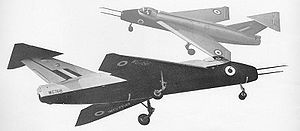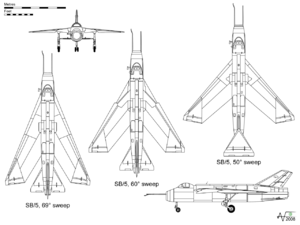Short SB5 Video - Picture

|
|
Short SB5
SB5

Role: experimental aircraft
Manufacturer: Short Brothers
First flight: 2 December 1952
Retired: 1967
Primary user: Royal Aircraft Establishment
Number built: 1
The Short SB5 (serial WG768) was a "highly unorthodox, adjustable wing" British research aircraft designed by Short Brothers in response to requirement ER.100; to provide input for the design of the English Electric P.1 (prototype of the English Electric Lightning) by testing the low speed flight characteristics of various configurations of wing-sweep required for supersonic flight. In addition, the tailplane could be mounted either on top of the fin ("T-tail") or below the fuselage. The tests ultimately confirmed that the original P.1/Lightning design was an effective configuration for high speed flight.
Design and development
A technical dispute arose between the Royal Aircraft Establishment and the English Electric Company (EEC) as to the optimum configuration for the company's proposed supersonic fighter. A single-seat, mid-winged research machine was built to investigate the low speed handling of the possible configurations. The same basic configuration of the P.1 was incorporated into a simpler testbed that had a fixed undercarriage.Since the SB5 was to test the low-speed flight characteristics, there was no requirement for the undercarriage to be retractable.
The contract was awarded to Short Brothers and Harland Ltd of Belfast on 2 August 1950. The machine was designed to allow three different wing sweep angles (50°, 60° and 69°). The sweep adjustment of the wings was made when the aircraft was on the ground. Two different tail plane positions (a) low on the rear fuselage and (b) on top of the fin, were also tested. This requirement was met by the construction of two entirely different rear fuselages and tail units.
"The complete rear fuselage, just aft of the engine, was detachable and two alternative rear fuselages were available, one with the tailplane set on top of the fin and the other with the tailplane set below the fuselage. The tailplane angle was adjustable in flight, being electrically actuated."
The wings were made "of plywood, except for light alloy sheeting at the leading and trailing edges," which restricted the maximimum speed to a modest 350 knots (403 mph; 649 km/h).
"Two 20 feet [6.1 m] circumference brake parachutes and one 20 feet [6.1 m] anti-spin parachute ... housed in the rear fuselage above the jet pipe."
The flight test report of the SB5 with 60 degrees of sweep and the tailplane in the lower position summarised the design criteria:
"At the time of the initial conception of the Short SB5 research aircraft (1949), it was recognised that the trend towards higher angles of sweepback was likely to continue, and this was emphasised by the existence of a design for an operational fighter aircraft, the English Electric P1 (Lightning), which was to have a sweepback of 60°. There was then no flight experience with wings of this amount of sweepback. The SB5 was designed to allow a gradual approach to this configuration, flying initially with 50° sweepback before conversion to 60° when it would resemble, aerodynamically, a seven-eighths scale model of the Lightning. To increase its usefulness as a research vehicle, the aircraft was capable of further modification to operate with 69° of wing sweepback."
History
Testing was conducted with increasing degrees of sweep and with the tailplane in both of its two possible positions:
The experience gained with the SB5 validated the wing-sweep and low tailplane configuration adopted for the P.1, which was to become the English Electric Lightning. Over eleven months, the tests with 50° and 60° sweep were concluded with the high tail configuration. In January 1954, the low tail rear fuselage was fitted and tests continued for a further two years and proved that the EEC configuration was correct.
Before evaluating the final wing sweep configuration of 69°, a Martin Baker ejector seat was fitted for the first time and the Rolls-Royce Derwent engine was changed for a Bristol Orpheus of greater thrust. The aircraft was returned to RAE Bedford in September 1960. The first flight was made in the new configuration on 18 October.
After completion of its test programme, the SB5 eventually joined the fleet of the Empire Test Pilots' School (ETPS) at Farnborough in 1967, as is evidenced by the ETPS 25th Anniversary brochure in 1968. The Empire Test Pilots School flew the machine to give students experience in flight-testing "slender" aircraft.
The SB5 is now on display in the RAF Museum, Cosford in Shropshire (with both of its tails).
Operators
United Kingdom
Royal Aircraft Establishment
Specifications (Short SB5- 1952 configuration (high tail))

Picture - Orthographic projection of the SB5, with 60° sweep. The plan views show the 69° sweep setting (left) and 55° (right).
Data from
General characteristics
Crew: 1
Length: 45 ft 9 in (13.94 m)
Wingspan: 35 ft 2 in (10.9 m)
Height: 17 ft 4 in (5.28 m)
Wing area: 330 ft² (30.66 m²)
Airfoil: symmetrical
Empty weight: 9,200 lb (4,173 kg)
Loaded weight: 12,000 lb (5,443 kg))
Powerplant: 1x— Rolls-Royce Derwent Mk. 8 turbojet, 3,600 lb (16.01 kN)
Fuel capacity: 300 Imp. gallons
Performance
Maximum speed: 403 mph (350 knots, 649 km/h) permissible
Related development:
English Electric Lightning
Comparable aircraft:
Handley-Page HP.115
Saab 210
"Empire Test Pilots' School: Twenty Five Years". Empire Test Pilots' School Twenty-fifth Anniversary brochure. 1968.
"Sweepback-60°". Shorts Quarterly Review, Vol. 2, No. 3. Autumn 1953.
Staples, K.J. "Tests on the Short SB5 with 60° and Low Tailplane - Part I- Forces and Moments". London: Office of Public Sector Information HMSO, 1969.
Winchester, Jim. X-Planes and Prototypes. London: Amber Books Ltd., 2005. ISBN 1-904687-40-7.
Short SB5 Pictures
Living Warbirds: The best warbirds DVD series.
Source: WikiPedia